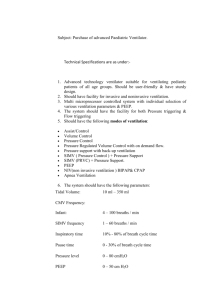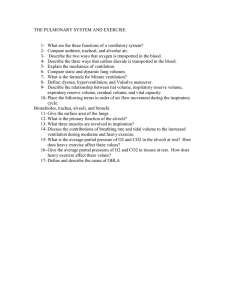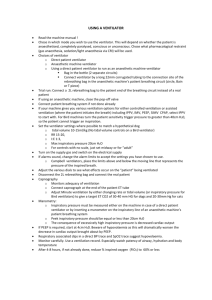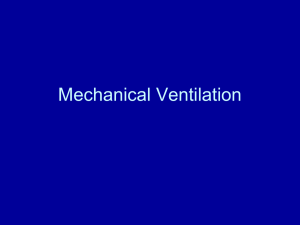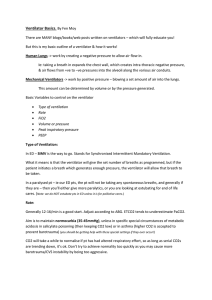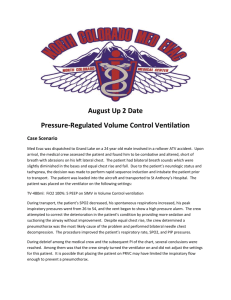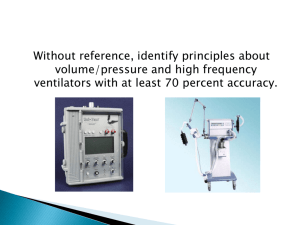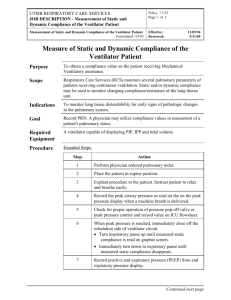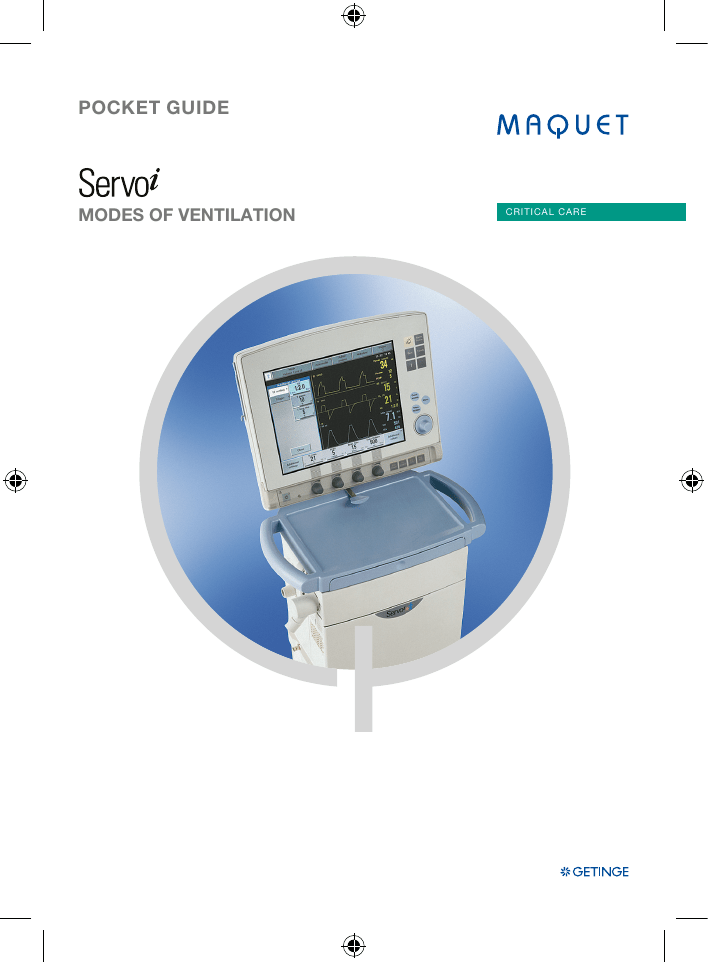
POCKET GUIDE
MODES OF VENTILATION
CRITI CAL CARE
CONTENT
3
4
6
7
8
10
12
14
16
18
19
23
24
26
30
Content
Introduction, Flow Pattern
PEEP, Auto PEEP
Inspiratory rise time, Cycle-off
Trigger Sensitivity
Volume Control – VC
Pressure Control – PC
Pressure Regulated Volume Control – PRVC
Pressure Support – PS
Continuous Positive Airway Pressure – CPAP
Volume Support – VS
Bi-Vent
Automode®
Synchronized Intermittent Mandatory Ventilation – SIMV
References
3
INTRODUCTION TO MODES OF VENTILATION
FLOW PATTERN
Mechanical ventilation is required when a patient is unable to achieve
adequate ventilation and thereby gas exchange. The ventilation pattern
must be adapted to suit the patient’s need for oxygenation and CO2
elimination. The Servoi Ventilator system provides ventilation modes,
which clinicians can tailor to the patient’s need.
Note: This Pocket Guide only covers selected topics and cannot
replace the User’s manual and the Service manual. For detailed
information please always refer to the latest corresponding User’s
manual and/or instructions for use.
Abbreviations
VC
PC
PRVC
PS
CPAP
VS
SIMV
In Pressure Control, Pressure Regulated Volume Control (PRVC), Pressure
Support, Volume Support, SIMV (PRVC) with Pressure Support and SIMV
(PC) with Pressure Support the flow is decelerating and the pressure is
constant.
Volume Control
Pressure Control
Pressure Regulated Volume Control
Pressure Support
Continuous Positive Airway Pressure
Volume Support
Synchronized Intermittent Mandatory Ventilation
Flow Pattern
The Flow Pattern in Volume Control and SIMV (VC) is constant during
inspiration. During the pause time the flow is zero.
At the beginning of expiration, flow is large. It gets smaller and smaller
and reaches zero by the end of expiration.
P resistance
Platau pressure
Time Constant Valve Controller™
To reduce the resistance in the beginning of expiration the expiratory
valve has a controlling algorithm, the Time Constant Valve Controller™,
which continuously calculates the elastic and resistive forces of the respiratory system. The initial opening of the expiratory valve is adapted
to keep resistance as low as possible while strictly maintaining the set
PEEP in the airway.
Peak pressure
P compliance
End exp. pressure
End insp. flow
End exp. flow
P = Pressure
V = Flow
V = Volume
4
5
PEEP, AUTO PEEP
INSPIRATORY RISE TIME, CYCLE-OFF
PEEP
Inspiratory rise time
A Positive End Expiratory Pressure is maintained in the alveoli to prevent
the collapse of the airways. An “optimal PEEP level” has been used for a
long time to protect the lung.
Inspiratory rise time: Time to peak inspiratory flow or pressure at the
start of each breath as a percentage of the respiratory cycle time or
in seconds. The Inspiratory rise time is adjustable from a very fast
response, where the patient basically performs only the triggering work,
to a more controlled delivery, where the patient can interact during the
inspiration.
The Inspiratory flow profile has to
be set to a comfortable value for
the patient and can be evaluated
by the shape of the flow and
pressure curves. Inspiratory rise
time % is applicable in all the
controlled modes of ventilation
(if configured for I:E ratio setting).
Inspiratory rise time in seconds is
applicable in Pressure Support,
CPAP and Volume Support.
Auto PEEP
If the respiratory rate is set high or the expiratory time is not long enough
there is a risk for auto PEEP. The patient does not have enough time to
exhale and it is evident on the flow curve that flow will not return to zero
before the next breath starts.
Inspiratory Cycle-off
There are different ways to check if the patient has an auto PEEP:
• The flow will not go back to zero before next inspiration starts.
• Vee is not zero, see 2nd page of Additional values on the User Interface.
• Total PEEP = set PEEP + Auto PEEP, press Expiratory Hold to see total
PEEP on 2nd page of Additional values on the User Interface.
6
Inspiratory Cycle-off is the point
at which inspiration changes to
expiration in spontaneous and
supported modes of ventilation.
It is important to set a proper
Inspiratory Cycle-off to avoid hyperinflation of the lungs and increased
work of breathing. If inspiration is
too long, the patient tries to exhale
by increasing the pressure and this
may result in too short a time for expiration. This problem may give an
Auto PEEP and increased work of breathing. Therefore it is important
to check the pressure and flow curves e.g. if the end expiratory flow
does not return to zero before next breath starts, the patient will have an
Auto PEEP. If the Inspiratory Cycle-off cuts off inspiration too early, the
patient will not get enough tidal volume.
7
TRIGGER SENSITIVITY
TRIGGER SENSITIVITY
Trigger Sensitivity
This determines the level of patient effort to initiate the inspiratory flow,
how much additional work of breathing the patient has to create to start
the inspiration. A delay in gas delivery tends to increase the work of
breathing. Trigger sensitivity can be set in flow or pressure triggering.
Normally flow triggering is preferable as the work of breathing should
be as low as possible, without self-triggering. Immediate sensing of
inspiratory effort from the patient is mandatory in achieving synchronicity
between the patient and the ventilator.
The ventilator continuously delivers a flow during each expiration
- In Adult the flow during expiration is 33 ml/sec (2 l/min)
- In Infant the flow during expiration is 8 ml/sec (0.5 l/min)
When the patient makes an inspiratory effort, the expiratory flow
transducer in Servoi, senses a decrease in the continuous expiratory
flow. When the difference between the inspiratory and expiratory
flow equals the preset flow trigger level the ventilator will start a new
inspiration.
The flow Trigger sensitivity setting is
divided in steps of 10%; each step
increases Trigger sensitivity. In the red
area the patient only has to inhale a very
small part of the trigger flow to trigger a
breath – risk for self triggering.
The pressure Trigger sensitivity can be set
within the range 0-20 cmH2O. To initiate
a breath the patient has to create the
negative pressure that is set as Trigger
sensitivity. The higher the negative Trigger
pressure is set on the ventilator, the
more work of breathing the patient must
perform. The Trigger sensitivity should
be set as sensitive as possible without
causing self triggering – auto triggering.
8
When the patient triggers a breath a purple T appears between the text
message and the alarm message areas. The initial part of the pressure or
flow curves changes to purple to indicate when the patient triggers the
breath. If the breath is flow-triggered the flow curve shows the purple
color but if the breath is pressure-triggered, then the pressure curve
shows the purple color.
Each expiration delivers a continous
flow. When the difference between
the inspiratory and the expiratory
flow equals the preset flow trigger
level the Servoi will start a new
inspiration.
9
VOLUME CONTROL – VC
VC
It is very important to set a sensitive triggering level to give the patient
the possibility to breathe by himself as soon as possible. If the patient
is making an inspiratory effort during the expiratory phase, he will get
an assisted breath with the same tidal volume as set on the ventilator.
Immediate sensing of inspiratory effort from the patient is mandatory in
achieving synchronicity.
In some cases, the patient may demand a higher tidal volume/flow than
is set on the ventilator e.g. if the patient has pain, has an increased
temperature, has change in the respiratory drive.
Volume Control – VC
In this controlled mode of ventilation the ventilator delivers the preset
tidal volume with a constant flow during the preset inspiratory time with
the preset pause time and at the preset respiratory rate.
The Peak Pressure can vary from breath to breath if the patients
Compliance and Resistance changes.
If we have a tight system the inspired tidal volume should be the
same as the expired tidal volume. The time for inspiration and expiration
can be configured to be set in I: E ratio or in seconds.
The flow-adapted Volume Controller™ will always work with the patient
and deliver the extra volume requested. If the patient decreases airway
pressure by 2 cmH2O during the inspiratory phase the ventilator switches
to Pressure Support and delivers a flow profile adapted to the patient’s
immediate needs.
Example
In Servoi you can select if you want to set the tidal volume or the minute
volume. The flow during volume control ventilation is constant. The insp.
time in % is seen in the information area in the menu Set ventilation
mode. Inspiratory rise time: Time to peak inspiratory flow at start of each
breath as a percentage of the respiratory cycle time.
How to calculate the flow
Example:
Preset Insp. Min. Volume = 6 l/min
Insp.time = 25%
Flow-adapted Volume Control
Gives inspiratory flow 6x100 =24 l/min
25
10
11
PRESSURE CONTROL – PC
PC
Pressure Control – PC
In this controlled mode of ventilation the ventilator delivers a flow to
maintain the preset pressure at a preset respiratory rate and during a
preset inspiratory time.
The pressure is constant during the inspiratory time and the flow
is decelerating. If for any reason pressure decreases during inspiration
the flow from the ventilator will immediately increase to maintain the set
inspiratory pressure.
The maximum available flow is 3.3 l/sec – 200 l/min for Adult and 0.56 l/sec –
33 l/min for Infant. The volume can vary from breath to breath if the patient’s
compliance and resistance changes. It is very important to set the alarm
limits for expired minute volume to adequate levels.
Inspiratory rise time in PC is the time to peak inspiratory pressure
and flow of each breath. Settings can be in the range 0–20% of the
respiratory cycle time - from an extremely fast response to a low initial
inspiratory flow.
Example:
Respiratory rate 15, the time for 1 breath is 60/15 = 4 sec
Inspiratory rise time 10% =
12
4x10
= 0.4 sec
100
The Servo i will sense the smallest deviations in pressure. A decrease in
pressure will occur when there is a leakage in the breathing system, at
the endotracheal tube, or in the lungs e.g. pneumothorax, fistula.
When previously collapsed airways are starting to open the pressure
decreases and the alveoli are opened by a precise increase in flow.
Active expiratory valve
If a patient tries to exhale during
the inspiration, pressure increases.
When it increases 3 cmH2O above
the set inspiratory pressure level,
the expiratory valve opens and
regulates the pressure down to the
set inspiratory pressure level.
If the pressure increases to the set
upper pressure limit e.g. the patient
is coughing, the expiratory valve
opens and the ventilator switches
to expiration.
13
PRESSURE REGULATED VOLUME CONTROL – PRVC
PRVC
If the measured tidal volume increases above the preset, the pressure
level decreases in steps of maximum 3 cmH2O between consecutive
breaths until the preset tidal volume is delivered.
If the measured tidal volume decreases below the preset, the pressure
level increases in steps of maximum 3 cmH2O between consecutive
breaths until the preset tidal volume is delivered.
Maximum available pressure level is 5 cmH2O below preset upper
pressure limit.
Pressure Regulated Volume Control – PRVC
PRVC is a controlled mode of ventilation which combines the advantages
of Volume Controlled and Pressure Controlled Ventilation. The Servo i
delivers the preset tidal volume with the lowest possible pressure. The
first breath delivered to the patient is a Volume Controlled breath. The
measured plateau pressure is used as the pressure level for the next
breath.The pressure is constant during the set inspiratory time and the flow
is decelerating. The set tidal volume is achieved by automatic, breathby-breath pressure regulation. The ventilator will adjust the inspiratory
pressure control level, according to the mechanical properties of the
airways/lung/thorax, to the lowest possible level to guarantee the preset
tidal volume.
14
If the pressure reaches 5 cmH2O below the upper pressure limit the
ventilator will deliver as much volume as possible with this pressure.
In the same time the information “Regulation Pressure Limited” (in the
alarm message area) will inform the user that the set volume cannot be
delivered with the set upper pressure limit. The alarm limit for expired
minute volume will also alert the user if properly set.
The Servo i will sense the smallest deviations in pressure. If it appears
that previously collapsed units of the lung are starting to open in the late
phase of inspiration the pressure tends to decrease, this is compensated
by a precise increase in flow and the alveoli are opened.
Terminal airway resistance decreases in discrete steps as pressure is
applied. By immediately sensing the pressure drop that could be induced
by an opening avalanche, Servoi provides proper flow to balance and
further enhance the opening process.
15
PRESSURE SUPPORT – PS
PS
It is important that the inspiration and expiration is adapted to the patient.
If the Cycle-off fraction is too short the patient will be left without proper
support for a period of the breath. It is important to avoid phases with
nearly no flow and late notches in the inspiratory flow curve. If this is the
case, the Inspiratory Cycle-off should be increased.
Pressure Support – PS
This is a spontaneous mode of ventilation. The patient initiates the breath
and the ventilator delivers support with the preset pressure level and a
decelerating flow. The patient regulates the respiratory rate and the tidal
volume with support from the ventilator.
In Pressure Support the set inspiratory pressure support level is kept
constant and there is a decelerating flow. The patient triggers all breaths.
If the mechanical properties of the lung/thorax and patient effort change,
delivered tidal volume will be affected. You then have to regulate the
pressure support level to get the desired ventilation.
The higher the preset inspiratory pressure level from the ventilator the
more gas flows into the patient. As the patient becomes more active the
pressure support level may be gradually reduced.
The Trigger sensitivity has to be set properly for the patient without
increase of the work of breathing. The patient has to inhale freely.
The Inspiratory rise time has to be set to a comfortable value for the
patient. This is the time to reach the peak inspiratory flow or pressure at
the start of each breath in seconds.
Normally in supported modes the Inspiratory rise time should be
increased from the default settings and give more comfort to the
patient.
Inspiratory Cycle-off is the point at which inspiration changes to
expiration. It is possible to set from 1% – 40% of inspiratory peak flow
for both infants and adults.
16
If the patient fails weaning it may be due to delayed termination of the
inspiratory support. If the inspiratory part of the breath is prolonged, the
patient will recruit his expiratory muscles and cycle the ventilator to expiration
by an increase in pressure. This process utilizes patient energy and may
shorten the time for expiration. This may induce Auto PEEP, increase work
of breathing and cause lost trigger efforts by an increased internal threshold
to triggering. In this case the Inspiratory Cycle-off should be increased. It is
important to monitor the corresponding tidal volume levels.
Pressure and flow curves
Inspiration starts when the patient
triggers a breath and gas flows into
the patient’s lungs at a constant
pressure. Since the pressure
provided by the ventilator is
constant, the flow will decrease
until the Inspiratory Cycle-off is
reached and then the expiration
starts. Depending on how the Inspiratory rise time is set, the flow will
be very fast rising or slower in the
beginning of the breath.
Expiration starts:
- When the inspiratory flow decreases to the preset Inspiratory Cycle-off level.
- If the upper pressure limit is exceeded.
- If the inspiration exceeds 2.5 seconds in Adult range and 1.5 seconds in Infant.
- If the flow drops to a flow range between 25% of the peak flow and lower
limit for Inspiratory Cycle-off fraction level and the time spent within this
range exceeds 50% of the time spent in between the start of the inspiration
and the entering this range.
17
PS, CONTINUOUS POSITIVE AIRWAY PRESSURE – CPAP
VOLUME SUPPORT – VS
If the apnea alarm limit is reached the ventilator will automatically switch
to the Back-up Mode, Pressure Controlled Ventilation. The Inspiratory
Pressure level can be set from 5 to 120 cmH2O - PEEP for Adult and 5
to 80 cmH2O - PEEP for Infant and as default is 20 cmH2O for Adult and
10 cmH2O for Infant. The I: E ratio, Respiratory Rate and Inspiratory rise
time are set to the default settings. Alarms will alert staff of the change,
the User Interface will display the message “Ventilating in Back-up
Mode. Change mode or go back to support mode!”
Volume Support – VS
Volume Support is a spontaneous mode; the patient has to initiate the
breath and the ventilator delivers support in proportion to the inspiratory
effort and the target volume. This mode of ventilation avoids ventilator
induced hyperinflation, but compensates and adapts to changes in
respiratory load. The set tidal volume will be delivered to the patient with
different support from the ventilator depending on the patient’s activity.
If the patient’s activity increases the Inspiratory pressure support will
decrease provided the set tidal volume is maintained. If the patient
breathes below the set tidal volume the inspiratory pressure support will
increase. The inspiratory flow will be decelerating.
The user has to decide if the patient can breath spontaneously or not and
the user has to select:
- Support mode
- Change mode
The start-up sequence is 4 breaths. The first breath is given with a
support of 10 cmH2O. From that breath the ventilator continually
calculates and regulates the pressure needed to deliver the preset tidal
volume. During the remaining 3 breaths, the maximum pressure increase
is 20 cmH2O for each breath. After the start-up sequence, if the delivered
Continuous Positive Airway Pressure – CPAP
The mode Continuous Positive Airway Pressure is used when the patient
is breathing spontaneously. CPAP works in exactly the same way as
Pressure Support, but the pressure support level is set to zero.
18
19
VS
VS
tidal volume is below the set tidal volume the pressure support level is
increased in steps of maximum 3 cmH2O breath by breath until the
preset tidal volume is delivered. If the delivered tidal volume is above
the set tidal volume the pressure support level is decreased in steps of
maximum 3 cmH2O until the preset tidal volume is delivered.
The inspiratory pressure support level automatically adapts to changes
in lung/thorax mechanical properties and patient effort. To evaluate the
patient’s own work of breathing it is easy to go into the trend and look
at the airway pressure. When the airway pressure declines, the patient is
taking over more of the respiratory work.
By combining Volume Support with compressible volume compensation,
flow variations which can induce high pressure drops across the
endotracheal tube are compensated for on-line by a proper increase in
pressure delivery.
The Inspiratory rise time has to be set to a comfortable value for the
patient. This is the time to reach the peak inspiratory flow or pressure at
the start of each breath in seconds. Normally in supported modes the
Inspiratory rise time should be increased from the default settings and
thus give more comfort to the patient. Inspiratory Cycle-off is the point at
which inspiration changes to expiration.
It’s important that the inspiration
and expiration is adapted to the
patient. If the Cycle-off fraction
is too short the patient will be left
without proper support for a period
of the breath. It’s also important to
avoid phases with nearly no flow
and late notches in the inspiratory
flow curve. If this is the case,
Inspiratory Cycle-off should be
increased.
20
If the patient fails weaning it may be due to delayed termination of the
inspiratory support. If the inspiratory part of the breath is prolonged,
the patient will recruit his expiratory muscles and cycle the ventilator to
expiration by an increase in pressure.
This process utilizes patient energy and may shorten the time for
expiration. This may induce Auto PEEP, increase work of breathing and
cause lost trigger efforts by an increased internal threshold to triggering.
In this case the Inspiratory Cycle-off should be increased.
Pressure and flow curves
Inspiration starts when the patient triggers a breath and gas flows into
the patient’s lungs at a constant pressure. Since the pressure provided
by the ventilator is constant, the flow will decrease until the Inspiratory
Cycle-off is reached and then the expiration starts.
Depending on how the Inspiratory rise time is set, the flow will be very
fast rising or slower in the beginning of the breath.
Expiration starts:
- When the inspiratory flow decreases to the preset Inspiratory Cycle-off level.
- If the upper pressure limit is exceeded.
- If the inspiration exceeds 2.5 seconds in Adult range and 1.5 seconds in Infant.
- If the flow drops to a flow range between 25% of the peak flow and lower
limit for Inspiratory Cycle-off fraction level and the time spent within this
range exceeds 50% of the time spent in between the start of the inspiration
and the entering this range.
21
BI-VENT
VS
Bi-Vent
The Bi-Vent mode is a pressure
controlled breathing mode giving
the patient the opportunity for unrestricted spontaneous breathing.
In this mode the ventilator uses
two shifting pressure levels and
the patient can breathe spontaneously at both these levels. It
is also possible to support the
patient with Pressure Support at
both pressure levels.
Example:
Phigh is set to 2 sec and PEEP is set to 4 sec and this will give you 6
sec for the Bi-Vent cycle. The mandatory rate will be 60/6 = 10 breaths
per minute. The Bi-Vent cycle may be shifted somewhat depending on
the patient and the ventilator settings since the ventilator continuously
synchronizes with the patient’s breathing. Since Bi-Vent is a controlled
mode of ventilation, back-up ventilation is not available.
If the apnea alarm limit is reached the ventilator will automatically switch
to the Back-up Mode, Volume Controlled Ventilation, with the same tidal
volume as in Volume Support. During Back-up ventilation default settings
are used for I:E ratio, Respiratory rate and Inspiratory rise time.
Alarms will alert staff of the change, the User Interface will display the
message“Ventilating in Back-up Mode. Change mode or go back to
support mode!”
The user has to decide if the patient can breathe spontaneously or not
and the user has to select: Support mode or Change mode.
Every Bi-Vent cycle has time for the Phigh and for the PEEP level. The time for Phigh can
be set 0.2 – 10 sec and the time for PEEP can be set 0.2 – 10 sec. This means that you
can set the mandatory rate from 3-150 breaths per minute.
22
23
AUTOMODE ®
AUTOMODE ®
The start-up algorithm for Automode will protect against false triggering.
The ventilator initially adapts with the adjustable Trigger Timeout. Trigger
Timeout is the maximum allowed apnea time in Automode before
controlled ventilation is activated. This means that for the spontaneously
breathing patient the Trigger Timeout limit increases successively.
The patient has to breathe 10 breaths in a row before the ventilator will
wait the whole Trigger Timeout period before switching to controlled
ventilation. If the patient triggers fewer breaths the ventilator will
decrease the time when it switches to controlled ventilation. The time
before the ventilator switches from support to controlled ventilation
will be shorter and shorter the fewer breaths the patient triggers. If the
patient breathes more than 10 breaths in a row and then stops it will take
the set Trigger Timeout, e.g. 7 seconds, before the ventilator initiates
controlled ventilation.
Patient activity can be seen by looking at the trend, which will indicate
the activity of the patient over 24 hours.
Automode®
Automode is an interactive mode of ventilation. The combined control
and support function of the ventilator adapts to the patient’s breathing
capacity. Automode allows the patient to go into a support mode
automatically if he triggers the ventilator, thereby better adapting
ventilation to patient effort. If the patient is not making any breathing
effort the ventilator will deliver controlled breaths.
Automode gives both the patient and clinician an optimal means of
commencing the weaning period at the time of initiating ventilator therapy.
Essentially the ventilator works in two modes: control or support.
When the patient, in control mode, makes an inspiratory effort, the
ventilator reacts by supplying a supported breath.
Early detection and adaptation to patient effort promotes spontaneous
breathing and early weaning. At the first sensing of spontaneous effort,
Automode delivers supported breaths adapted to patient’s effort, instead
of a controlled mechanically pre-programmed pattern.
Three different coupling modes combining control and support are available:
Volume Control
PRVC
Volume Support
Pressure Control
24
Volume Support
Pressure Support
25
SIMV
SYNCHRONIZED INTERMITTENT MANDATORY VENTILATION
Synchronized Intermittent Mandatory Ventilation – SIMV
During SIMV the patient receives mandatory breaths controlled by the
ventilator. These mandatory breaths are synchronized with the breathing
efforts of the patient. The patient can breathe spontaneously in between
the mandatory breaths. The spontaneous/pressure supported breath is
defined by setting the Pressure Support level above PEEP.
There are three different SIMV modes:
- SIMV Volume Control and Pressure Support
- SIMV Pressure Control and Pressure Support
- SIMV PRVC and Pressure Support
SIMV PRVC + Pressure Support
SIMV(VC)+PS
SIMV(PRVC)+PS
X
X
PC above PEEP
tidal volume /
SIMV(PC)+PS
X
minute volume
SIMV rate
X
X
Breath cycle time
X1
X1
X1
I:E ratio /
X
X
X
Inspiratory rise time
X
X
X
Pause time
X
X
Inspiration time
SIMV VC + Pressure Support
1 Only when the ventilator is configured for I:E ratio setting
The mandatory breath is defined by the basic settings (as shown in table above): minute
volume/tidal volume (depending on configuration), PC above PEEP, I:E ratio, Inspiration
time (depending on configuration), Pause time, Inspiratory rise time and Breath cycle
time.
Note: In the minute volume configuration the tidal volume is determined by minute
volume divided by SIMV rate.
SIMV PC + Pressure Support
26
27
SIMV
SIMV
Breath Cycle Time (Breath Cycle T)
This is the length of the total respiratory cycle of the mandatory breath.
The total time for inspiration, pause and expiration.
Note: This is if the Servoi is configured for setting the inspiratory time by
setting the I:E ratio.
The SIMV cycle in seconds is calculated as follows: 60 seconds divided
by the SIMV rate. The SIMV cycle is divided into a SIMV period and a
spontaneous period.
If the patient is not breathing at all only the mandatory breaths will be
delivered. When the patient starts to breathe he will get the Pressure
Support in the spontaneous period and if triggering in the SIMV period
the set mandatory breath will be delivered. In the next SIMV period the
ventilator will wait for the patient to trigger but if the patient has not
triggered within the first 90% of the breath cycle time (SIMV period) a
mandatory breath will be delivered.
Example:
Following settings are made:
SIMV rate 6
Breath Cycle time 3 sec
I:E ratio 1:2
The time for the mandatory breath is
3 sec = SIMV period
I:E ratio 1:2 = 1 sec for inspiration,
2 sec for expiration
The time for one SIMV cycle is 60 sec divided by the
set SIMV rate. In this example 60/6 = 10 sec
The time for the spontaneous period is 10-3 = 7 sec
28
29
REFERENCES AND SUGGESTED READING
Amato MB, Barbas CS, Medeiros DM,
et al. Effect of a protective-ventilation
strategy on mortality in the acute
respiratory distress syndrome. N Engl J
Med 1998; 338:347-54.
Böhm S, Lachmann B. Pressurecontrol ventilation. Putting a mode into
perspective. Int J Int Care 1996;3:12-27
Paul E. Marik, MD; and Jim Krikorian,
RRT. Pressure-Controlled Ventilation
in ARDS: A Practical Approach. Chest
1997; 112:1102-6.
Suter PM, Fairley HB, Isenberg MD.
Optimum end-expiratory airway pressure
in patients with acute pulmonary failure.
N Engl J Med 1975; 292:284–289.
Hickling KG, Walsh J, Henderson S, et
al: Low mortality rate in adult respiratory
distress syndrome using low-volume,
pressure-limited ventilation with
permissive hypercapnea: A prospective
study. Crit Care Med 22:1568-1578, 1994
Esteban A, Alia I, Gordo F, et al.
Prospective Randomized Trial Comparing
Pressure-Controlled Ventilation and
Volume-Controlled Ventilation in ARDS.
Chest 2000; 117:1690–1696.
Ranieri M, Giuliani R, Fiori T, et al.:
Volume-pressure curve of the respiratory
system predicts effects of PEEP in
ARDS: “occlusion” versus “constant
flow” technique. Am J Respir Crit Care
Med 1994, 149:19–27.
30
Holt SJ, Sanders RC, Thurman TL,
Heulitt MJ. An evaluation of Automode,
a computer-controlled ventilator mode,
with the Siemens Servo 300A ventilator,
using a porcine model. Respir Care 2001
Jan;46 (1):26-36
Marini JJ. Pressure-targeted, lungprotective ventilatory support in acute
lung injury. Chest 1994: 105: 109S–115S.
A. Piotrowski MD, W. Sobala MD, et al.
Patient-initiated, pressure-regulated,
volume-controlled ventilation compared
with intermittent mandatory ventilation
in neonates: a prospective, randomised
study. Int.Care Med (1997) 23: 975-981
Keenan Heather, MD, Martin Lynn, MD,
Volume Support Ventilation in Infants
and children: Analysis of a Case Series.
Respir. Care 1997;3:281 – 287.
Ramet J., Suvs B., et al. Weaning
Outcome in Children According to
the Pre-weaning ventilatory Modes.
Respiratory and Critical Care Medicine,
1995;151(4):A424.
Ramet J., Idrissi S., et al. The Effects
of Pressure Regulated Volume Control
Ventilation on Sedation Requirements.
Respiratory and Critical Care Medicine,
1995;151(4):A744.
Apostolakos Michael J., MD, Levy Paul
C. MD. et al. New Modes of Mechanical
Ventilation.
Clin Pulm Med 1995;2:121-128.
H Roth, M Quintel, R Tillmans, et al.:
Interactive ventilation: first experience
with patient controlled weaning by using
a Siemens –SV300 Automode ventilator.
Crit Care 1998,2 (suppl 1):P81
Hazelzet Jan A. MD, Petru Ronald MD. et
al. New Modes of Mechanical Ventilation
for Severe Respiratory Failure. Critical
Care Medicine 1993;9(Suppl.):S366S367.
Masaji Nishimura, Dean Hess, and Robert
M. Kacmarek. The Response of Flowtriggered Infant Ventilators. Am J Crit
Care Med Vol 152. pp 1901-1909, 1995
Tremblay LN., Slutsky AS., The role of
pressure and volume in ventilator induced
lung injury. Applied Cardiopulmonary
Pathophysiology. 1996 6:179-190.
Maquet Critical Care AB
SE-171 95 SOLNA
Sweden
Phone: +46 8 730 73 00
www.maquet.com/criticalcare
Not for circulation in the USA.
© Maquet Critical Care AB 2003. All rights reserved.
MAQUET reserves the right to modify the design and
specifications contained herein without prior notice.
Order No. 66 14 692 E315E
Printed in Sweden
WS 1203 5.
Rev.01 English
December 2003
Price: Group 1

